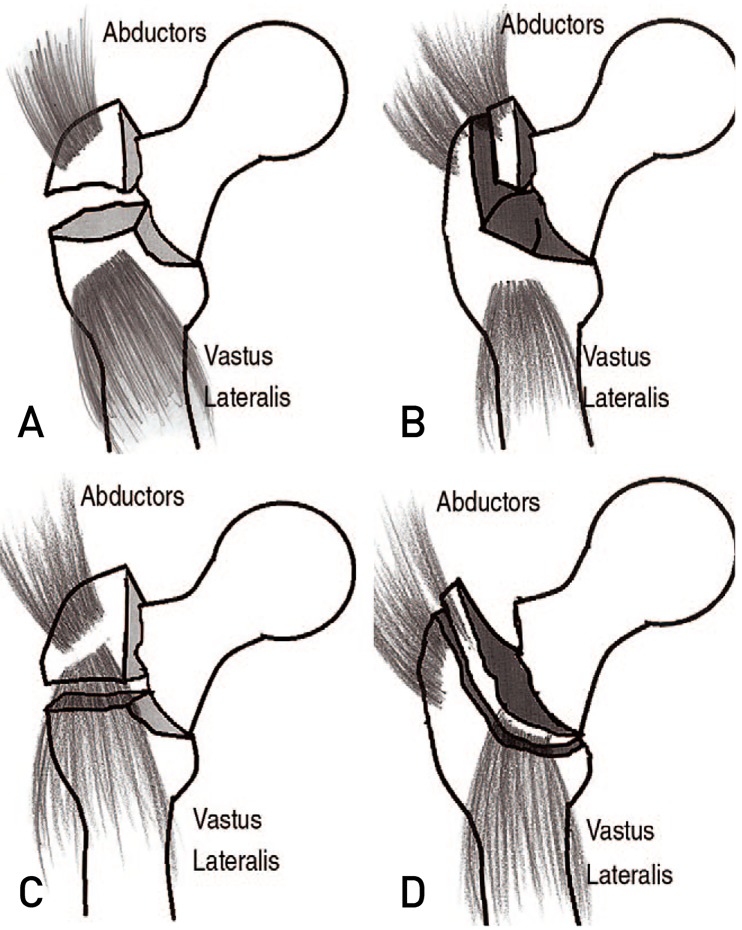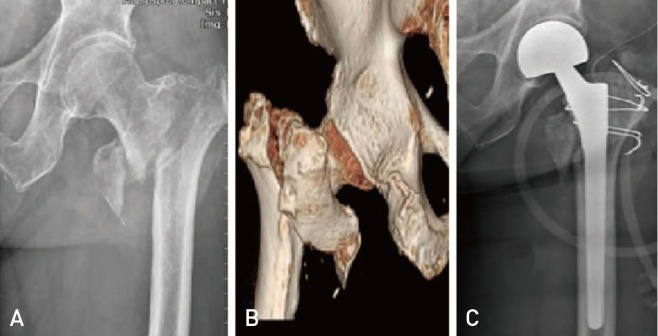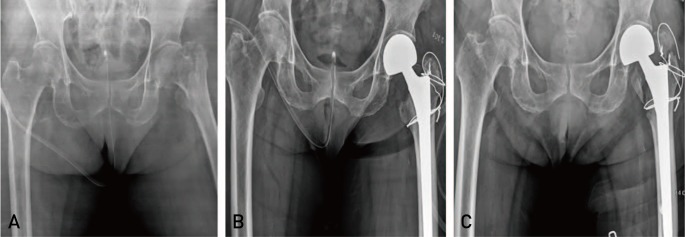Hip Pelvis.
2019 Sep;31(3):144-149. 10.5371/hp.2019.31.3.144.
Selecting Arthroplasty Fixation Approach Based on Greater Trochanter Fracture Type in Unstable Intertrochanteric Fractures
- Affiliations
-
- 1Department of Orthopaedic Surgery, Kwangju Christian Hospital, Gwangju, Korea. wonderchung@naver.com
- KMID: 2455987
- DOI: http://doi.org/10.5371/hp.2019.31.3.144
Abstract
- PURPOSE
To evaluate the success rate of fixation approaches for greater trochanter (GT) fracture types in those with unstable intertrochnateric fractures.
MATERIALS AND METHODS
Forty-four patients who underwent arthroplasty for unstable intertrochanteric fractures between January 2015 and November 2017 and followed-up more than six months were included in this study. The fractures of GT were classified into one of four types (i.e., A, B, C, and D) and fixed using either figure-8 wiring or cerclage wiring according to fracture type. Fractures were type A (n=7), type B (n=20), type C (n=6), and type D (n=11). Type A and B, which are fractures located above the inferior border of GT were fixed using figure-8 wiring and/or adding cerclage wiring. On the other hand, all type C and D fractures, which were located below the inferior border, were fixed using cerclage wiring. Fixation failure was defined as breakage of wire and progressive migration of GT fragment greater than 5 mm on follow-up radiographs.
RESULTS
The most common GT fracture types were B and D, both of which are longitudinal fractures. The success rates of fixation were 85.7% (6 out of 7 cases) for the treatment of type A, 90.0% (18 out of 20 cases) for the treatment of type B, and 100% for the treatment of types C (6 out of 6 cases) and D (11 out of 11 cases).
CONCLUSION
We note high success rates following fixation methods were selected based on the GT fracture type.
Figure
Reference
-
1. Dhanwal DK, Dennison EM, Harvey NC, Cooper C. Epidemiology of hip fracture: Worldwide geographic variation. Indian J Orthop. 2011; 45:15–22. PMID: 21221218.
Article2. Broos PL, Rommens PM, Geens VR, Stappaerts KH. Pertrochanteric fractures in the elderly. Is the Belgian VDP prosthesis the best treatment for unstable fractures with severe comminution? Acta Chir Belg. 1991; 91:242–249. PMID: 1950312.3. Fan L, Dang X, Wang K. Comparison between bipolar hemiarthroplasty and total hip arthroplasty for unstable intertrochanteric fractures in elderly osteoporotic patients. PLoS One. 2012; 7:e39531. PMID: 22745778.
Article4. Celiktas M, Togrul E, Kose O. Calcar preservation arthroplasty for unstable intertrochanteric femoral fractures in elderly. Clin Orthop Surg. 2015; 7:436–442. PMID: 26640625.
Article5. Stern MB, Goldstein TB. The use of the Leinbach prosthesis in intertrochanteric fractures of the hip. Clin Orthop Relat Res. 1977; (128):325–331.
Article6. Sun D, Park BS, Jang GI, Lee B. The fixation method according to the fracture type of the greater trochanter in unstable intertrochanteric fractures undergoing arthroplasty. Hip Pelvis. 2017; 29:62–67. PMID: 28316964.
Article7. Park BJ, Cho HM, Min WB. A comparison of internal fixation and bipolar hemiarthroplasty for the treatment of reverse oblique intertrochanteric femoral fractures in elderly patients. Hip Pelvis. 2015; 27:152–163. PMID: 27536619.
Article8. Cho HM, Lee SR, Park MS, Chung WC. Standard type cemented hemiarthroplasty with double loop and tension band wiring for unstable intertrochanteric fractures in the elderly. J Korean Hip Soc. 2010; 22:159–165.
Article9. Hamadouche M, Zniber B, Dumaine V, Kerboull M, Courpied JP. Reattachment of the ununited greater trochanter following total hip arthroplasty. The use of a trochanteric claw plate. J Bone Joint Surg Am. 2003; 85:1330–1337. PMID: 12851359.10. Kim WY, Han CH, Park JI, Kim JY. Failure of intertrochanteric fracture fixation with a dynamic hip screw in relation to preoperative fracture stability and osteoporosis. Int Orthop. 2001; 25:360–362. PMID: 11820441.
Article11. Grimsrud C, Monzon RJ, Richman J, Ries MD. Cemented hip arthroplasty with a novel cerclage cable technique for unstable intertrochanteric hip fractures. J Arthroplasty. 2005; 20:337–343. PMID: 15809952.
Article12. Kim JH, Lee S, Jeong SY, Park JS, Seo YH. Bipolar hemiarthroplasty using the greater trochanter reattachment device (GTRD) for comminuted intertrochanteric fracture in elderly patients. J Korean Hip Soc. 2004; 16:441–446.13. Choi DH, Heo JY, Jang YJ, Chung YY. Fixation of the greater trochanter in arthroplasty for unstable intertrochnateric fracture. J Korean Fract Soc. 2014; 27:58–64.
Article14. Clawson DK. Intertrochanteric fracture of the hip. Am J Surg. 1957; 93:580–587. PMID: 13403091.
Article15. Koyama K, Higuchi F, Kubo M, Okawa T, Inoue A. Reattachment of the greater trochanter using the Dall-Miles cable grip system in revision hip arthroplasty. J Orthop Sci. 2001; 6:22–27. PMID: 11289581.
Article16. Kim WY, Han CH, Ji JH, Kim YY, Lee KS, Lee SW. Fixation for reattachment of trochanteric fragment in pertrochanteric fracture treated with bipolar hemiarthroplasty. J Korean Hip Soc. 2006; 18:67–72.
Article17. Suh YS, Choi SW, Park JS, Yim SJ, Shin BJ. Comparison between the methods for fixation of greater trochanteric fragment in cemented bipolar hemiarthroplasty for unstable intertrochanteric fracture. J Korean Hip Soc. 2008; 20:104–109.
Article18. Chin KR, Brick GW. Reattachment of the migrated ununited greater trochanter after revision hip arthroplasty: the abductor slide technique. A review of four cases. J Bone Joint Surg Am. 2000; 82:401–408. PMID: 10724232.
- Full Text Links
- Actions
-
Cited
- CITED
-
- Close
- Share
- Similar articles
-
- Fixation of the Greater Trochanter in Arthroplasty for Unstable Intertrochnateric Fracture
- The Fixation Method according to the Fracture Type of the Greater Trochanter in Unstable Intertrochanteric Fractures Undergoing Arthroplasty
- Cement Filling Technique to Prevent Greater Trochanter Displacement in Hip Arthroplasty for Femoral Intertrochanteric Fracture: A Technical Note
- New Wiring Method for Lesser Trochanter Fixation in Unstable Intertrochanteric Fractures: Technical Note
- Changes of the Fracture Fragments of Lesser Trochanter after Operative Treatment in the Unstable Femoral Intertrochanteric Fractures





